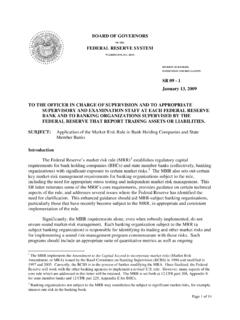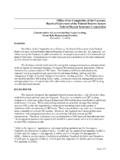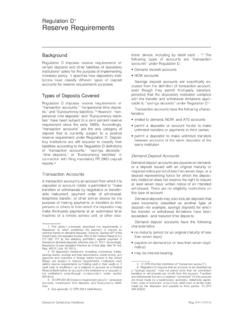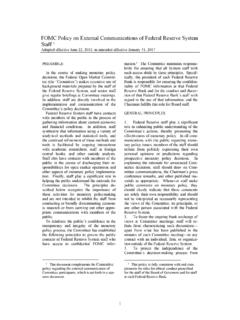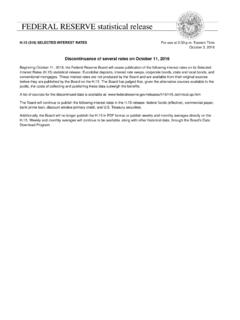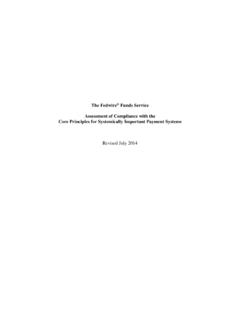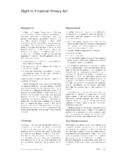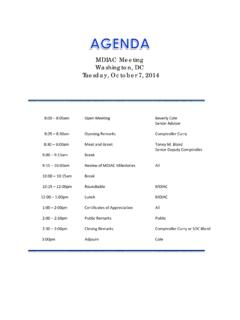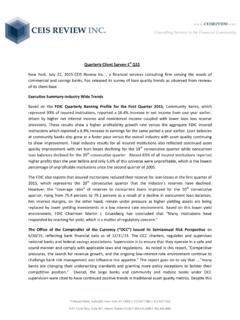Transcription of Interest on Reserves and Arbitrage in Post-Crisis Money ...
1 Finance and Economics Discussion SeriesDivisions of Research & Statistics and Monetary AffairsFederal reserve Board, Washington, on Reserves and Arbitrage in Post-Crisis Money MarketsThomas Keating and Marco Macchiavelli2017-124 Please cite this paper as:Keating, Thomas, and Marco Macchiavelli (2017). Interest on Reserves andArbitrage in Post-Crisis Money Markets, Finance and Economics Discussion Se-ries :Board of Governors of the Federal reserve System, : Staff working papers in the Finance and Economics Discussion Series (FEDS) are preliminarymaterials circulated to stimulate discussion and critical comment. The analysis and conclusions set forthare those of the authors and do not indicate concurrence by other members of the research staff or theBoard of Governors. References in publications to the Finance and Economics Discussion Series (other thanacknowledgement) should be cleared with the author(s) to protect the tentative character of these on Reserves and Arbitrage in Post-Crisis Money Markets Thomas Keating Marco Macchiavelli1 November 01, 2017 ABSTRACT Currently, Eurodollars and fed funds markets combined trade about $220 billion in funds daily, the vast majority of which with overnight tenor.
2 In this paper, we document several features of these wholesale unsecured dollar funding markets. Using daily confidential data on wholesale unsecured borrowing and reserve balances, we show that foreign banks, which make up most of the trading volumes in these markets, keep around 99% of each additional Eurodollar and 80% of each fed fund borrowed as reserve balances. With these risk-free trades, banks earn the spread between Interest on Reserves and the borrowing rate. Relative to foreign banks, large domestic institutions borrow less often, but when they do, they keep around 99% of each additional Eurodollar or fed fund raised as Reserves . Small domestic banks do not display any correlation between net borrowing and their Reserves accumulation. We also discuss how regulatory costs affect trading patterns and Interest rate differentials in wholesale dollar funding markets.
3 JEL Classification: E43, E52, G21. Keywords: Interest on Reserves , Arbitrage , Monetary policy, Fed funds, Eurodollars. 1 Keating and Macchiavelli Federal reserve Board of Governors, Monetary Affairs. We are grateful to staff members in the Money Market Analysis, and Monetary Policy Operations and Analysis for comments. The views expressed in this paper are those of the authors and do not necessarily reflect those of the Board of Governors or the Federal reserve System. 1 1. Introduction The set of liquidity injections put in place by the Federal reserve to fight the financial crisis created, as a by-product, a large amount of excess Reserves . The abundance of excess Reserves , in turn, pushed the effective fed funds rate below its target (Bech and Klee (2011)) and in order to set a floor for the effective fed funds rate, the Federal reserve started to pay Interest on Reserves (IOR).
4 Many cash lenders that participate in Money markets are not banks, and therefore are not eligible to earn IOR; as a result, they are willing to lend overnight wholesale funds at rates below IOR. This segmentation creates an opportunity for banks to borrow overnight wholesale funds to keep as reserve balances, earning the positive spread between IOR and the overnight funding rate. As these trades involve no credit or Interest rate risk for the borrowing bank, we call these trades IOR Arbitrage trades .2 In this paper, we use confidential, daily data to empirically document several salient features of IOR Arbitrage trades. We show that such Arbitrage trades are concentrated at institutions that are subject to lower regulatory costs; namely, most branches and agencies of foreign banks (henceforth foreign banks ) are exempt from paying fdic fees and are subject to a less stringent implementation of the Basel III leverage ratio, relative to domestic banks.
5 Both factors make IOR Arbitrage trades less costly for foreign institutions relative to domestic ones. We find that foreign banks make up most of the Eurodollars and fed funds borrowing by volume, and keep on average around 99% of each additional Eurodollar and 80% of each fed fund borrowed as reserve Compared to foreign banks, large domestic institutions borrow unsecured funds less often and in smaller quantities, but when they do, they keep around 99% of 2 As we discuss later in the paper, several factors other than the payment of IOR affect each institution s demand for Reserves . 3 Throughout the paper we refer to the correlation between net borrowing and changes in reserve balances held as pass-throughs. 2 each additional Eurodollar or fed fund raised as Reserves . Since domestic banks incur an additional regulatory cost when conducting such Arbitrage , they are only willing to borrow at a lower Interest rate than their foreign counterparts.
6 Small domestic banks borrow unsecured funds too, but not for the purpose of conducting IOR Arbitrage their pass-through from unsecured borrowing to reserve balances is not significantly different from We also find that several institutions borrow on a daily basis from both the fed funds and the Eurodollar markets; these cross-market linkages provide a rationale for the tight correlation between the fed funds and Eurodollar Indeed, most days the two effective rates are identical. Finally, we discuss the impact of the Basel III leverage ratio on dynamics in unsecured funding markets (window dressing). In particular, some banks located in jurisdictions that compute the leverage ratio using month-end or quarter-end snapshots deleverage on such dates: they drop wholesale borrowing on the liability side and shed Reserves on the asset side, resembling the unwinding of an IOR Arbitrage trade.
7 To this point, we show that the IOR Arbitrage result is not just due to these large month-end deleveraging patterns, but rather, is on month-ends, but rather, it occurs consistently throughout the month. Competitive bidding for unsecured funding should push up the effective federal funds rate to the level at which most banks are indifferent between further borrowing in the fed funds market to fund a reserve position and not borrowing. Consistent with this hypothesis excluding month- 4 We refer to some banks as small to differentiate them from the largest banks in the panel, which we define as the top 15 banks by reserve balances for each fdic status. However, none of the banks in our sample are particularly small: only banks with more than $18 billion in assets, or banks with assets between $5 and $18 billion but with fed funds activity of more than $200 million in two or more days in the previous three months need to report.
8 5 Fed funds are unsecured loans in dollars from exempt entities (mainly banks and government-sponsored enterprises) to a office of a bank. Eurodollars are unsecured loans in dollars from insuredentities (mainly non-financial corporations and Money market mutual funds) to banks offices outside the United States. These offshore funds are then routinely transferred onshore. Since fed funds and Eurodollars are regulated similarly and are not subject to reserve requirements, banks consider them close substitutes. Under Regulation D, federal funds transaction are exempt from reserve requirements and since 1990 net Eurodollar deposits have been subject to a reserve requirement ratio of zero percent. 3 ends when foreign banks pare back their IOR Arbitrage the effective fed funds rate has recently traded around nine basis points below the IOR rate (see Figure 1), which is close to the average fdic fee paid by domestic In other words, the effective fed funds rate seems to trend around the level that makes the average domestic bank indifferent between engaging in IOR Arbitrage or not.
9 It is important to point out that the Arbitrage trades we identify, namely raising additional overnight funding to hold as reserve balances, can also serve an additional purpose. In the Post-Crisis world, access to intraday credit from clearing banks has been limited, prompting banks active in repo markets to seek out other sources of intraday credit and to hold precautionary liquidity One way for these entities to bootstrap intraday credit is to borrow funds in the wholesale market and hold the balances as Reserves . These Reserves can be used to substitute for intraday credit around, for example, repo settlement windows and then be held as reserve balances overnight to earn the IOR rate. Additionally, with the opportunity cost of holding Reserves diminished, banks may want to hold additional Reserves to avoid daylight overdrafts (Bech et al.)
10 (2012) and Lipscomb et al. (2017)).8 There are several papers that explain how the Post-Crisis monetary policy regime works through Arbitrage , for example, ( Beck, Klee (2011), Ihrig et al. (2015), Frost et al. (2015)). To the best of our knowledge, we are the first to empirically document these IOR Arbitrage trades, and which groups of banks engage in them. In particular, for each group of banks (large vs. small, 6 In July 2016, the fdic introduced a bps surcharge for banks with more than $10 billion in assets; in addition, the March 2017 fdic quarterly banking profile shows the distribution of assessment base rates, averaging bps, excluding the surcharge. Thus, large banks face an overall fdic premium of about 8 to 9 bps. 7 See 8 Note that funding Reserves by borrowing overnight in the wholesale market does not generally improve a bank s liquidity coverage ratio (LCR): the increase in the LCR numerator due to holding Reserves , a level 1 high quality li quid asset (HQLA), is counteracted by a higher LCR denominator due to increased unsecured overnight wholesale funding, which receives a 100 percent runoff rate.
